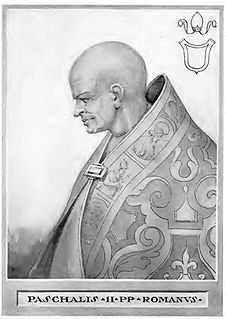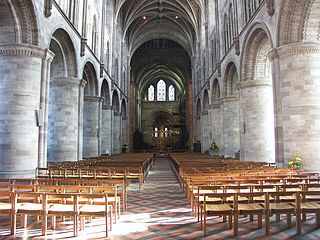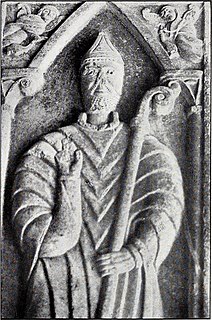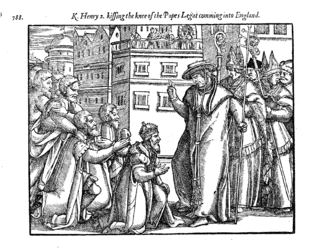A papal judge delegate was a type of judicial appointment created during the 12th century by the medieval papacy where the pope would designate a local judge, often an ecclesiastic, to decide a case that had been appealed to the papal court. [1]
A papal judge delegate was a type of judicial appointment created during the 12th century by the medieval papacy where the pope would designate a local judge, often an ecclesiastic, to decide a case that had been appealed to the papal court. [1]
The system began during the pontificate of Pope Pascal II (1099–1118), when the first records appear of the papacy delegating some of its judicial authority to others for the resolution of cases. At first, it was used in order to expedite the discovery of local knowledge of cases, rather than to reduce the papal court's workload. Examples of this early stage include a case from Wales, during the pontificate of Pope Innocent II. This was a dispute between Bernard, the Bishop of St Davids, and Urban, the Bishop of Llandaff, and was apparently delegated to acquire local knowledge of the dispute. It is only later, during the pontificate of Pope Alexander III that the papal courts appears to have recognized that the delegation system could also reduce the volume of cases that had to be decided at Rome. [2] [3]

Pope Paschal II, born Ranierius, was head of the Catholic Church and ruler of the Papal States from 13 August 1099 to his death in 1118.

Pope Innocent II, born Gregorio Papareschi, was head of the Catholic Church and ruler of the Papal States from 14 February 1130 to his death in 1143. His election was controversial and the first eight years of his reign were marked by a struggle for recognition against the supporters of Antipope Anacletus II. He reached an understanding with Lothair II, Holy Roman Emperor who supported him against Anacletus and whom he crowned King of the Romans. Innocent went on to preside over the Second Lateran council.

The Bishop of St Davids is the ordinary of the Church in Wales Diocese of St Davids.
An important factor in the growth of the papal judges-delegate system was the corresponding growth of the papal judicial system during the 12th century. [4] Often, cases referred to a judge-delegate were those that were particularly complex, and where the local knowledge of the appointee would be helpful. The appointment ended with the resolution of the case he had been appointed to decide. [1]
The numbers of judges-delegate increased greatly during the 1160s and 1170s. English records for this time are particularly abundant, with a number of English bishops – including Gilbert Foliot, Bartholomew Iscanus, Roger of Worcester – serving over 60 times as judge-delegate for the papacy. [1] Conflicts often arose between papal legates and judges-delegate, and Pope Celestine III ruled that a papal legate could not change the decision of a judge-delegate but was allowed to confirm or implement the decision. Celestine did indicate that the legate was higher in rank than the judge, although he was sovereign in matters relating to his appointed case. [1] Alexander III's decrees on the judicial delegation system form the basis for the description of the system in Pope Gregory IX's Decretales which were published in 1234. Of the 43 items dealing with papal judges-delegate in the Decretales, 18 are Alexander's and a further 15 are from Pope Innocent III. [3]

Gilbert Foliot was a medieval English monk and prelate, successively Abbot of Gloucester, Bishop of Hereford and Bishop of London. Born to an ecclesiastical family, he became a monk at Cluny Abbey in France at about the age of twenty. After holding two posts as prior in the Cluniac order he was appointed Abbot of Gloucester Abbey in 1139, a promotion influenced by his kinsman Miles of Gloucester. During his tenure as abbot he acquired additional land for the abbey, and may have helped to fabricate some charters—legal deeds attesting property ownership—to gain advantage in a dispute with the Archbishops of York. Although Foliot recognised Stephen as the King of England, he may have also sympathised with the Empress Matilda's claim to the throne. He joined Matilda's supporters after her forces captured Stephen, and continued to write letters in support of Matilda even after Stephen's release.

Bartholomew Iscanus was a medieval Bishop of Exeter. He came from Normandy and after being a clerk of the Archbishop of Canterbury, was made Archdeacon of Exeter in 1155. He became bishop of Exeter in 1161. He was known as having excellence in canon law and theology and during his time as bishop visited all the parishes in the diocese to investigate how well-managed they were.
Roger of Worcester was Bishop of Worcester from 1163 to 1179. He had a major role in the controversy between Henry II of England, who was Roger's cousin, and Archbishop Thomas Becket.
Papal documents referred to the delegates as iudices delegati. [1] A further development was the grant of exemptions from appointment as judge-delegate, with such exemptions first appearing around 1140. By the end of the 12th century, such exemptions were sought after by local ecclesiastics. [3]

Pope Alexander II, born Anselm of Baggio, was pope from 1061 to his death in 1073. Born in Milan, Anselm was deeply involved in the Pataria reform movement. Elected on 30 September according to the terms of his predecessor's bull, In nomine Domini, Anselm's was the first election by the cardinals without the participation of the people and minor clergy of Rome.

Pope Honorius II, born Lamberto Scannabecchi, was head of the Catholic Church and ruler of the Papal States from 21 December 1124 to his death in 1130.

Pope Callixtus II or Callistus II, born Guy of Burgundy, was head of the Catholic Church and ruler of the Papal States from 1 February 1119 to his death in 1124. His pontificate was shaped by the Investiture Controversy, which he was able to settle through the Concordat of Worms in 1122.

Pope Leo XI, born Alessandro Ottaviano de' Medici, was head of the Catholic Church and ruler of the Papal States from 1 to 27 April 1605. His pontificate is one of the briefest in history having lasted under a month. He was from the prominent House of Medici originating from Florence. Medici's mother opposed his entering the priesthood and sought to prevent it by having him given secular honours, but after her death he eventually was ordained a priest in 1567. In his career he served as Florence's ambassador to the pope, Bishop of Pistoia, Archbishop of Florence, papal legate to France, and as the cardinal Prefect for the Congregation of the Bishops and Religious. He was elected to the papacy in the March 1605 papal conclave and served as pope for 27 days.

Pope Lucius II, born Gherardo Caccianemici dal Orso, was head of the Catholic Church and ruler of the Papal States from 9 March 1144 to his death in 1145. His pontificate was notable for the unrest in Rome associated with the Commune of Rome and its attempts to wrest control of the city from the papacy.

A papal legate or apostolic legate is a personal representative of the pope to foreign nations, or to some part of the Catholic Church. He is empowered on matters of Catholic faith and for the settlement of ecclesiastical matters.
Decretals are letters of a pope that formulate decisions in ecclesiastical law of the Catholic Church.
The Treaty of Benevento, or Concordat of Benevento, was an important treaty between the papacy of Adrian IV and the Norman Kingdom of Sicily. After years of turbulent relations, the popes finally settled down to a peace with the Hauteville kings.
Giovanni di San Paolo was a Benedictine monk at San Paolo fuori le Muri in Rome. He was made Cardinal-Deacon on February 20, 1193, then Cardinal Priest of Santa Prisca in May 1193 and finally Cardinal Bishop of Sabina at the end of 1204. He is often referred to as a member of the powerful Roman Colonna family, but modern scholars have established that this is based on the falsehood from the beginning of 16th century. More likely he was nephew of Celestine III and member of the Bobone family. He studied medicine at Amalfi.
Gerardo Allucingoli was an Italian cardinal and cardinal-nephew of Pope Lucius III, who elevated him in 1182.

Hilary (c. 1110–1169) was a medieval Bishop of Chichester in England. English by birth, he studied canon law and worked in Rome as a papal clerk. During his time there, he became acquainted with a number of ecclesiastics, including the future Pope Adrian IV, and the writer John of Salisbury. In England, he served as a clerk for Henry of Blois, who was the Bishop of Winchester and brother of King Stephen of England. After Hilary's unsuccessful nomination to become Archbishop of York, Pope Eugene III compensated him by promoting him to the bishopric of Chichester in 1147.

The papal election of 1198 was convoked after the death of Pope Celestine III; it ended with the election of Cardinal Lotario dei Conti di Segni, who took the name Innocent III. In this election for the first time the new pope was elected per scrutinium.

In 1148, a Council of Reims was called by Pope Eugene III to consider a number of regulations, or canons, for the Church, as well as to debate some other issues. Originally the summons for the council went out in October 1147 and it was supposed to be held in Trier, which is now in Germany, but conditions in Trier were such that it was moved to Reims, in France, for February 1148. A number of the summoned bishops and other church officials did not attend and Eugene suspended many of the non-attendees, excepting the Italian ecclesiastics, who were excused. The council lasted 11 days, and convened on 21 March 1148. From 400 to 1100 ecclesiastics are considered to have attended, although this number does not include the various servants and officials of the attendees, who would have swelled the numbers.

The papal election of 1154 followed the death of Pope Anastasius IV and resulted in the election of Pope Adrian IV, the only Englishman to become pope.

The papal election of 1153 followed the death of Pope Eugene III and resulted in the election of Pope Anastasius IV.

The papal election of 1143 followed the death of Pope Innocent II and resulted in the election of Pope Celestine II.

The papal election of 1144 followed the death of Pope Celestine II and resulted in the election of Pope Lucius II.

The papal election of 1145 followed the death of Pope Lucius II and resulted in the election of Pope Eugene III, the first pope of the Order of Cistercians.
A legatine council or legatine synod is an ecclesiastical council or synod that is presided over by a papal legate.
The Tuscan League, also known as the League of San Genesio, was formed on 11 November 1197 at Borgo San Genesio by the chief cities, barons and bishops of the Duchy of Tuscany shortly after the death of the Emperor Henry VI. The league was the work of Pope Celestine III and his two papal legates: Pandulf, cardinal priest of Santi Apostoli, and Bernard, cardinal priest of San Pietro in Vincoli. It was directed against the Holy Roman Emperor in alliance with the papacy. Its members swore not to make any alliances without papal approval, nor to make any peace or truce "with any emperor, king, prince, duke or margrave" without the approval of the rectors of the league. The original signatories were the communes of Lucca, Florence and Siena, the people living under the castles of Prato and San Miniato, and the bishopric of Volterra. The city of Arezzo joined on 2 December; Pisa refused and was placed under interdict by Celestine.

The International Standard Book Number (ISBN) is a numeric commercial book identifier which is intended to be unique. Publishers purchase ISBNs from an affiliate of the International ISBN Agency.